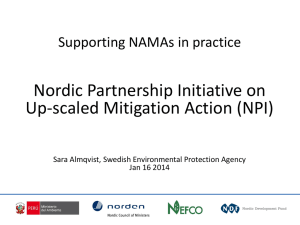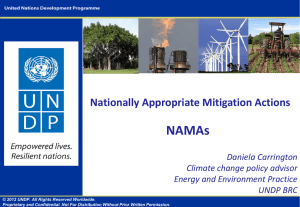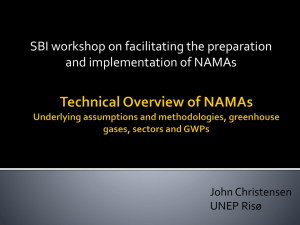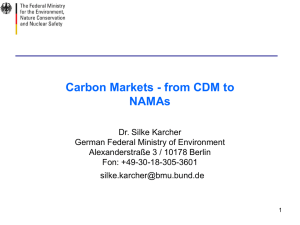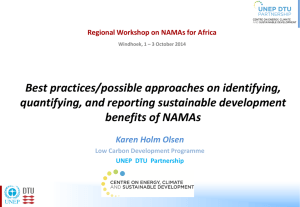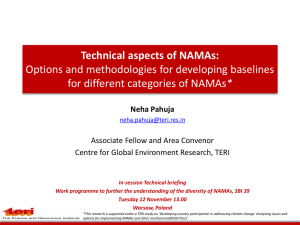JCM - unfccc
advertisement
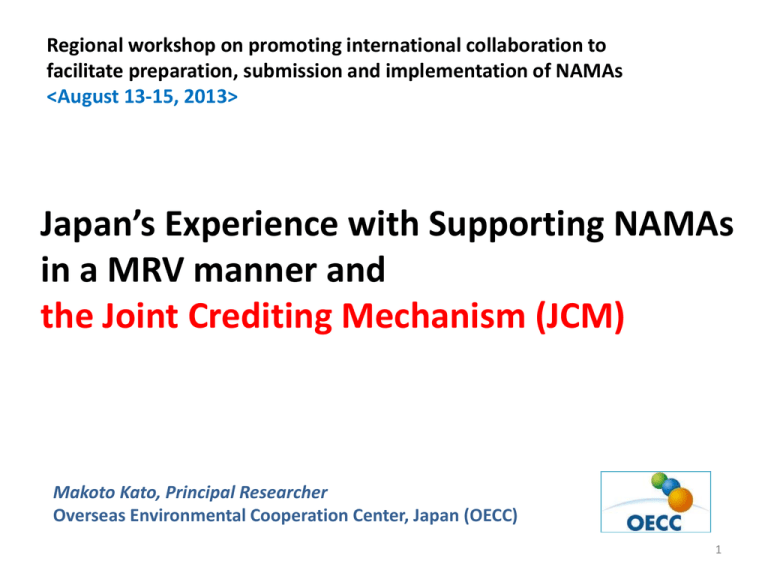
Regional workshop on promoting international collaboration to facilitate preparation, submission and implementation of NAMAs <August 13-15, 2013> Japan’s Experience with Supporting NAMAs in a MRV manner and the Joint Crediting Mechanism (JCM) Makoto Kato, Principal Researcher Overseas Environmental Cooperation Center, Japan (OECC) 1 Outline 1. Summarizing Elements of NAMAs in a MRV manner in COP decisions and sorting out relevant information 2. Experience with developing NAMAs in a MRV manner under the MOEJ* Programme 3. Joint Crediting Mechanism (JCM) – a driver to implement NAMAs with technology, finance, and capacity-building 2 * Ministry of the Environment, Japan 1. Summarizing Elements of NAMAs in a MRV manner in COP decisions and sorting out information 3 1. Summarizing Elements of NAMAs in a MRV manner in COP decisions Elements of NAMAs • Subject to measurement, report, verification(MRV) (differentiated MRVs for domestic and international finance) • Access to Support with technology, financing, and capacity-building • Aims (at least) at deviation from business-as-usual emission (BAU) in 2020 • Reported together with GHG Inventory in BUR and described with quantitative goals and progress indicators • Encouraged to link with low carbon development strategies and planning 1/CP.13, 2/CP.15 Annex, 1/CP.16, and 2/17 and its Annex III As long as with these elements, NAI Parties can decide NAMAs as they like (while further elements may be agreed by the COP). 4 1. Summarizing Elements of NAMAs in a MRV manner in COP decisions Current Illustration of mitigation actions in relation to BAU New Market Mex GHG Emissions CDM Domestic efforts 20XX others International support 2020 (Target Year) NB. The above graphic does not include how accounting of GHG should be sorted out, in relation to offset mechanisms. Time 5 NAMA Response by NAI Parties to UNFCCC (examples) Country Target China 40-50% /GDP Colombia Depends on Unilateral Support Market Indonesia 26-41% (26% reduction thru unsupported NAMAs) Mongolia N/A Sectors for NAMAs Reference Level • • 15% for the share of non-fossil fuel Forest Coverage 40,000,000 ha • • • Unilateral - more than 7% RE in 2020 Support - Forest Market- CDM, NMM • • • • • • Sustainable Peat land Deforestation Forestry, Agriculture Renewable Energy Waste Transport BAU • • • Renewable Energy (PVs, Hydro etc.) Energy Supply (CHP, Building etc.) Industry (cement etc.) N/A 2005 BAU (depending on schemes) 6 Source: : Compilation of information on NAMAs (FCCC/AWGLCA/2011/INF.1) MRV for describing the international process * Guidelines decided by 2/CP.17 Annex III ** Details are not yet decided (subject to further decisions) BUR* Inventory NAMA etc. Developing Country International Consultation & Analysis (ICA)** MRV UNFCCC MRV describing Macrospective Review of Policy Action Implementation National Committee (verification at macro level) Possible Verification at macro level Secretariat of the Committee MRV Report on NAMAs • Assumption of GHG calculation • GHG quantification methodologies • Use of different schemes Verify UN Guidelines is being negotiated at SBSTA Ministries and institutions in charge Ministry Ministry Ministry NAMAs (to be designed and implemented as a package of policy or programme) Ministry Ministry Ministry NAMAs (Reduction Plan against Sectoral baselines) 8 NB. Guidelines on domestic MRV is being developed at SBSTA. The structure is a suggested model for policy level MRV. MRV at Activity level (Project or entity level) Project Design (Ex Ante GHG calculation) Emission Reduction Activity (Monitoring GHG ) Project complete (Ex post GHG calculation) Verification MRV * Guidelines on methodologies are not (yet) decided by the UN 2.Experience with developing NAMAs in a MRV manner under the MOEJ Programme 10 2. Experience with developing NAMAs in a MRV manner under the MOEJ Programme Quantifying GHG Emissions Reduction Climate Change Sectoral Strategy Energy Sector Strategy Others Activity1: Data and Info. collection *Extract data and make fact sheets Fig 1. Energy Development Plan in BAU and NAMAs 2012 BAU NAMAs XXX MWh 2020 X,XXX MWh - X,XXX MWh Fig 2. GHG Emissions in BAU and NAMAs 2012 BAU NAMAs XXX t-CO2 - 2020 Activity2: GHG Emissions Calculation Activity3: Identify Mitigation Action X,XXX t-CO2 - XX MW Solar - XX units Boilers X,XXX t-CO2 11 Proposed Steps for NAMA Development (1) Collection of Info on relevant policies and strategies Collect and analyze relevant policy documents of development, climate change and related sector (eg national power development plan) (3) Quantification GHG emissions of BAU (5) Quantification GHG emission reduction by NAMAs Quantify GHG emissions based on (2) data, and a) Identify the calculation formulas b) Calculate respective emission in BAU c) Aggregate respective emissions Quantify GHG emissions with (4)NAMAs assumptions a) Set the calculation formulas b) Calculation c) Aggregate potential with reduction by NAMAs (2) Collection data for BAU in the sector Collect data for calculating BAU emission with bottom-up approach (eg. List all power plants in operation and planned, based on national power development plan) Source: OECC 2012 (4) Examination and selection of NAMAs options Select possible NAMAs options and technologies based on (1) policies and mitigation strategies and additional consideration. Low-carbon technology survey Examination MRV methods Capacity-buildings in Vietnam for NAMAs implication 12 BAU: Energy Demand Projection in Cambodia In case where sectoral development strategies is available, such information may be useful for projection a priori. (If not, application of model should be necessary) (MW) 2,500 2,000 High case (GDP Growth Rate: 6%) Based case (5%) Low case (3%) 2,085 1,688 1,500 1,120 1,000 500 2011 2012 2013 2014 2015 2016 2017 2018 2019 2020 13 Source: OECC (Overseas Environmental Cooperation Center, Japan) 2012, modifying JICA Study BAU: Power Development Plan in Cambodia *Need to consider projects which may be developed in BAU out of the present plan. No. 1 2 3 4 5 6 7 8 9 10 11 12 13 … Project Name XXXX YYYY ZZZZ AAAA Kamchay Kirirom III Stung Atay Stung Tatay Lower Stung Russei Churum 100 MW Coal Fired Power Plant 270 MW Phase 1 of the 700MW Coal Fired Power Plant 100 MW Coal Fired Power Plant 430 MW Phase 2 of the 700MW Coal Fired Power Plant … Total Capacity Condition as of Year (MW) Dec. 2011 Heavy Fuel Oil 340 Coal 13 Operating Hydro 13 Wood, Biomass 6 Hydro 194 2012 Hydro 18 2012 Hydro 120 2012 Under Hydro 246 2013 Construction Hydro 338 2013 Coal 100 2013 2014 Coal 270 PPA singed ~2015 Coal 100 2016 PPA singed Type Coal 430 Coal α* 2188+α 2017 FS completed 20XX May be developed* 14 Source: OECC 2012 Power Development Plan with mitigation options No. 1 2 3 4 5 6 7 8 Project Name XXXX YYYY ZZZZ AAAA Kamchay Kirirom III Stung Atay Stung Tatay 9 Lower Stung Russei Churum 10 100 MW Coal Fired Power Plant 270 MW Phase 1 of the 700MW 11 Coal Fired Power Plant 12 100 MW Coal Fired Power Plant 430 MW Phase 2 of the 700MW 13 Coal Fired Power Plant … … Total Capacity Year (MW) Heavy Fuel Oil 340 Coal 13 Hydro 13 Wood, Biomass 6 Hydro 194 2012 Hydro 18 2012 Hydro 120 2012 Hydro 246 2013 Type Hydro 338 Coal 100 2013 Coal 2013 2014 270 ~2015 100 2016 Coal 430 2017 Coal α* 2188+α 20XX Coal Introduction of highperformance boiler Promotion of renewable energy (hydro, solar, biomass 15 Source: OECC 2012 Preparing for Domestic Institutional Arrangement GHG Inventory as a measurement pillar Climate Change Committee (verification at macro level) Secretariat of the Committee Possible Verification at macro level • Assessment of Mitigation Plans • Verification of the progress report • Review of aggregated GHG emission reduction • Assessment of challenges and further needs(PDCA cycle) • Submission and Report to UNFCCC Report Ministries and institutions in charge Ministry Ministry Ministry Ministry Implementation and verification at micro level* Ministry Ministry (ER from individual activities/projects) Verification varies by different financial schemes * For a policy measures not as a project-based(such as taxation policy, etc.) may be MRVed at the macro level but still need to have some ways for QA/QC of collected data within its programme. Non-market Regular monitoring and data collection procedure (such as that of energy regulatory committee’s) JCM/BOCM JCM meth, third party verification CDM CDM meth, monitoring, DOE 16 verification Mongolia Selected Sector: Energy Supply Sector NAMAs: Improvement of CHP Plants Working Group: MEDG, Ministry of Energy, other key institutes and experts, chaired by Climate Change Special Envoy Results: Calculated BAU and ER by NAMAs ex ante both for power and heat supplies for CHP3 and CHP4 Sorted out reporting process of activity data (ie Energy Regulatory Committee) Discussed technology options for application in NAMAs, including process diagnosis in CHP Diagnosis by energy technology experts from Japan at CHP Lao PDR Selected Sector: Transport Sector NAMAs: Replacement of conventional vehicle with EV Working Group: 7 Ministries participates, including MONRE, MPWT, MIME, MOIC, MOST, chaired by Results: • Calculated BAU and ER by NAMAs ex ante • Activity data (fuel economy data) originally collected and based on JICA Study • Proposed institutional arrangements are planned to be a part of technical WG under the National Climate Change Committee Motorcycle Baseline Emissions Baseline fuel economy (km/liter) Baseline fuel economy (km/liter) (2020) Driving distance (km/day) CO2 emission factor (kgCO2/liter) Days per year Baseline emission (tCO2/year/vehicle) BAU NAMA Project Emissions Driving distance (km/day) Project electricity economy (kWh/km) Grid electricity emission factor (tCO2/MWh) Days per year Project emission (tCO2/year/vehicle) Emission reduction (tCO2/year/vehicle) Source: Basic Data Collection Study on Number of EV Low-emission Public Transport System in Total Emission Reduction (tCO2/year) Lao PDR, JICA, modified by OECC Song Thew / Passenger Tuk Tuk / Mini bus Middle size car bus Large bus 40 43.3 16 2.18 365 0.3 13.0 14.1 25 2.18 365 1.4 20 21.7 45 2.70 365 2.0 6.5 7.0 85 2.70 365 11.9 2.5 2.7 120 2.70 365 43.8 16 0.080 25 0.130 45 0.130 85 0.310 120 1.000 0.135 365 0.1 0.135 365 0.2 0.135 365 0.3 0.135 365 1.3 0.135 365 5.9 0.2 1.3 1.8 10.6 37.9 698000 45000 12000 4000 1000 161,204 56,280 21,065 42,537 37,887 Total 18 318,973 Viet Nam Selected Sector: Waste Sector NAMAs: CH4 Reduction from Landfill (semi aerobic technology) Working Group: MONRE, MOC, MPI, VEA, IMHEN, chaired by IMHEN Results: • Collected historical activity data from all landfills in Viet Nam •Calculated BAU and reduction by NAMA candidates (Emission Reductions from Methane Emission from LFs) •Discussed possible reporting procedures 19 Cambodia Selected Sector: Agricultural Sector NAMAs: National Bio digester Programme Working Group: MOE, MPWT, MIME chaired by MOE DG Results: • Calculated BAU and ER by NAMAs ex ante (Emission Reductions from Methane Reduction and NRB) • Sorted out reporting procedure CH4 Emission from animal manure and its Reduction by biodigester Programme CO2 reduction from non renewable biomass by different fuels 20 3.Joint Crediting Mechanism (JCM) – a driver to implement NAMAs with technology, finance, and capacity-building 21 Basic Concept of JCM Facilitating diffusion of leading low carbon technologies, products, systems, services, and infrastructure as well as implementation of mitigation actions, and contributing to sustainable development of developing countries. Appropriately evaluating contributions to GHG emission reductions or removals from Japan in a quantitative manner, by applying measurement, reporting and verification (MRV) methodologies, and use them to achieve Japan’s emission reduction target. Contributing to the ultimate objective of the UNFCCC by facilitating global actions for GHG emission reductions or removals, complementing the CDM. 22 Approach of JCM The JCM is being designed and implemented, taking into account the followings: 1. Ensuring the robust methodologies, transparency and the environmental integrity; 2. Maintaining simplicity and practicality based on the rules and guidelines; 3. Promoting concrete actions for global GHG emission reductions or removals; 4. Preventing uses of any mitigation projects registered under the JCM for the purpose of any other international climate mitigation mechanisms to avoid double counting on GHG emission reductions or removals. 23 Japan has signed on bilateral documents with developing countries Japan has held consultations for the JCM with developing countries since 2011 and signed the bilateral document for the JCM with Mongolia, Bangladesh, Ethiopia, Kenya, Maldives, and Viet Nam. Japan will continue consultations/briefing with any countries which are interested in the JCM Japan and Mongolia held the 1st Joint Committee. 24 Roadmap for the JCM JFY2011 JFY2012 Governmental Consultation JFY2013 Signing JCM Operation Establishment of the JC Bilateral Document Development of rules and guidelines Feasibility Studies Explore potential JCM projects/activities Study feasibilities Develop MRV methodologies MRV Model Projects Apply proposed MRV methodologies to projects in operation Improve MRV methodologies by using them Finalize MRV methodologies JCM Model Projects Further improve the institutional design of the JCM, while starting JCM operation Capacity Building UN negotiations on Framework for Various Approaches 25 JCM as a driver to implement NAMAs with technology, finance, and capacity-building • In addition to support for readiness, NAMAs require resources for implementation in near term. • To implement a national mitigation plan (in which mitigation actions contained), different financial options in a portfolio may be applied, including JCM. • In JFY2013, concrete GHG reduction activities (with financial investments and technology transfer) are expected for registration in the Joint Committees. • Japan operates several support measures to accelerate the implementation of NAMAs by using JCM. 26 For more information on JCM please visit New Mechanisms Information Platform (http://www.mmechanisms.org/e/) [Procedural Documents] • MOU concluded by countries • Rules of Implementation • Project Cycle Procedure • Guidelines for Third Party Entities • Guidelines for Methodologies • Guidelines for Validation & Verification etc. [Project Information] [Japan’s Support Programme] Thank you very much http://www.mmechanisms.org/e/ 28
